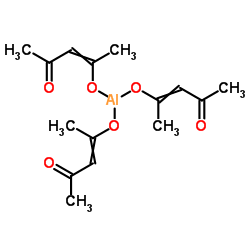Aluminum acetylacetonate

Aluminum acetylacetonate structure
|
Common Name | Aluminum acetylacetonate | ||
|---|---|---|---|---|
| CAS Number | 13963-57-0 | Molecular Weight | 324.305 | |
| Density | 1,27 g/cm3 | Boiling Point | 315 °C(lit.) | |
| Molecular Formula | C15H21AlO6 | Melting Point | 190-193 °C(lit.) | |
| MSDS | Chinese USA | Flash Point | 314-316°C | |
| Symbol |

GHS06 |
Signal Word | Danger | |
|
Does aluminum lactate cause spinal cord infarction in rabbits?
Environ. Health Perspect. 96 , 245, (1991)
|
|
|
Low-temperature synthesis of gamma-alumina nanocrystals from aluminum acetylacetonate in nonaqueous media.
Small 3(5) , 763-7, (2007)
|
|
|
Procedures for labeling the high-resolution axis of two-dimensional MQ-MAS NMR spectra of half-integer quadrupole spins.
Solid State Nucl. Magn. Reson. 21(1-2) , 21-43, (2002) The increasing development and application of the multiple-quantum MAS NMR for half-integer quadrupole spins has led to various RF pulse sequences for improving the excitation of multiple-quantum coherences and their conversion to single-quantum coherences. A... |
|
|
Cardiotoxicity of the lipophilic compound aluminum acetylacetonate in rabbits.
Biomed. Environ. Sci. 1(3) , 283-7, (1988) Aluminum acetylacetonate was administered to New Zealand white rabbits as liposome preparations and was found to distribute approximately 1:1 between water and phosphatidylcholine dipalmitoyl vesicles. Biochemical monitoring proved that after 2 weeks of daily... |
|
|
Experimental aluminum pathology in rabbits: effects of hydrophilic and lipophilic compounds.
Environ. Health Perspect. 89 , 217-23, (1990) Aluminum lactate [Al(lact)3] (hydrophilic, hydrolytically unstable) and aluminum acetylacetonate [Al(acae)3] (lipophilic, hydrolytically stable) were tested as potential toxicants to rabbits upon IV administration both as aqueous solutions and as liposome sus... |
|
|
Effects of aluminum speciation on murine neuroblastoma cells.
Mol. Chem. Neuropathol. 16(1-2) , 11-22, (1992) Murine neuroblastoma cells behave differently in the presence of Al(acac)3 [acac = 2,4-pentanedionate; acetylacetonate] or Al(malt)3 [malt = 3-hydroxy, 2-methyl, 4-pyronate; maltolate] with respect to Al(lac)3 [lac = 2-hydroxypropionate; lactate]. Thus, a rem... |
|
|
Interactions of Al(acac)3 with cell membranes and model phospholipid bilayers.
J. Inorg. Biochem. 75(4) , 263-8, (1999) Aluminum is a neurotoxic agent; however, little information has been obtained regarding its molecular cytotoxicity and the effects on the stability of biological membranes. This is mainly due to the ill-defined chemical speciation of the metal compounds. For ... |
|
|
Tris acetylacetonate aluminium(III) induces osmotic fragility and acanthocyte formation in suspended erythrocytes
Toxicol. Lett. 45(1) , 15-21, (1989) Tris acetylacetonate aluminium(III) (Al(acac) 3), dissolved in water, is effective in producing osmotic fragility in suspended erythrocytes in the concentration range of 0.034–0.34 mmol/l. Water solutions of Tris maltolate aluminium(III) (Al(malt) 3) and alum... |
|
|
A marked stimulation of Fe2+-initiated lipid peroxidation in phospholipid liposomes by a lipophilic aluminum complex, aluminum acetylacetonate.
Biochim. Biophys. Acta 1389(2) , 141-9, (1998) In the present study, the efficacy of a lipophilic Al complex, aluminum acetylacetonate, as a stimulator of Fe2+-initiated lipid peroxidation in phospholipid liposomes was examined, and results were compared with those from the liposomes treated with AlCl3. T... |
|
|
Aluminum (III) induces alterations on the physical state of the erythrocytic membrane: an ESR evaluation.
J. Inorg. Biochem. 65(2) , 109-14, (1997) The action of aluminum [Al(III)] as Al(acac)3 on erythrocytes causes biophysical effects such as osmotic fragility and echino-acanthocytes formation. In this paper, we present these effects in terms of variation of membrane fluidity, together with findings re... |